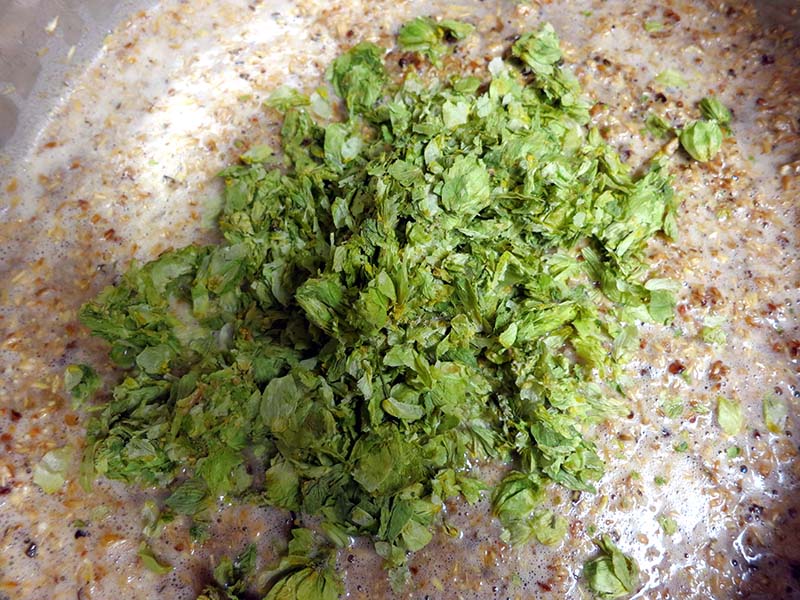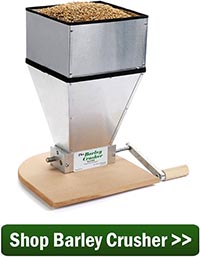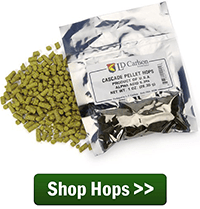 Over the past several years, IPAs and Double IPAs have been all the rage in the craft beer scene. Heady Topper, Pliny the Elder, and others have put hops in the spotlight. Though the term “hop bursting” has only just gained some notoriety, the technique could be the secret the success of these massively popular beers.
Over the past several years, IPAs and Double IPAs have been all the rage in the craft beer scene. Heady Topper, Pliny the Elder, and others have put hops in the spotlight. Though the term “hop bursting” has only just gained some notoriety, the technique could be the secret the success of these massively popular beers.
So what is hop bursting?
Hop bursting is simply adding massive amounts of late addition hops to the boil. Instead of early additions for the bulk of a beer’s bitterness. These late additions supply most of the IBUs.
Let me explain.
In a standard beer recipe, you may have an ounce of bittering hops, an ounce of flavor hops, and an ounce of aroma hops. Seems pretty balanced. However, since more bitterness is extracted the longer hops are boiled, the majority of the IBUs in this scenario come from the first addition. Just play around with an IBU calculator to see what I mean. With hop bursting, the first addition will be very small or even nonexistent, which means that most or all of the IBUs come from the later additions.
You’ll find that to achieve the same level of IBUs, hop bursting will require significantly more hops in total. However, this technique can help the brewer to achieve very intense hop flavor and aroma without overpowering bitterness.
If you’re a fan of massive hop flavor and aroma, try the hop bursting recipe below!
Hop Bursted Amarillo IPA
(partial mash recipe, five gallons)
Specifications
OG: 1.064
FG: 1.016
ABV: 6.3%
IBUs: 64
Boil time: 60 minutes
Ingredients
6.6 lbs. Light LME
1 lb. Amber DME
1 lb. Caramel 20L malt
 1 lb. Carapils malt
1 lb. Carapils malt
.5 oz. Amarillo hops at :30
1 oz. Amarillo hops at :15
1 tsp. Irish moss at :15
2 oz. Amarillo hops at :10
1.5 oz. Amarillo hops at :5
Yeast: Safale US-05
3/4 cup priming sugar
Directions
Steep the crushed Caramel 20L and Carapils malts for 30 minutes in one gallon of water at 152°F. Strain the grains and rinse them with 1 gallon of water at 170°F, collecting the runoff in the boil kettle. Mix in the liquid malt extract and top off to 7 gallons of wort. (To get 64 IBUs, you will need a 7 gallon boil. If using a 5 gallon kettle, top off to 4 gallons and increase the first hop addition to 1.5 oz.)
Boil for 60 minutes, adding the hops according to the schedule. Add 1 teaspoon of Irish moss with 15 minutes left in the boil. Whirlpool, chill, and transfer to a clean, sanitized fermenter. If needed, top off with enough water to make five gallons. Ferment at 66°-70°F for seven days. Rack to secondary for ten days. Bottle or keg as you would normally.
Are you a fan of the hop bursting technique? What’s your strategy? Do you have a hop bursting recipe or schedule you’d like to share? Put it in the comments section below…
—–
David Ackley is a beer writer, brewer, and self-described “craft beer crusader.” He holds a General Certificate in Brewing from the Institute of Brewing and Distilling and is founder and editor of the Local Beer Blog.

I am new to brewing so my question is when does the 1 lb of Amber DME get added? Is it the same time as the LME addition?
Darryl, we apologize for the confusion because the directions do not specify. Yes, the DME is added at the same time as the LME.
Hi Ed,
I’m currently experimenting with late hopping in my all grain beer with dubious results.
The beer is always good and drinkable but the hop burst or at least a clear recognition of hop flavour and aroma is weak.
To try to isolate the main contributor to flavour and aroma my last recipe used Galaxy pellets in a hop bag for the last 15 minutes of the boil with the quantity adjusted to give me a IBU/GU ratio of 0.96. (Pellets used in a hop bag as I do not have a whirlpool)
I am casking my beer in King Kegs. I rack it off the yeast after my fining process is complete and pressurise with a CO2 blanket.
I have tried most of the hopping techniques regularly discussed with only occasional moderate success. I am looking for a robust repeatable process that will enable hop recognition in my IPAs and so will be interested in your reply. What I like about your recipe above is it’s simplicity. This is a key factor for me. Many thanks in advance.Bob.
Bob, the key to hop bursting is the short amount of time the hops is in the boil. The aroma is not boiled off this way and the bitterness that takes time to extract does not over-power the hops character. If you have a recipe that is close, you can do the same recipe again only add another 1 to 2 ounces of appropriate hops in the last 1 to 5 minutes of the boil.
You may also want to look into dry hopping your beers for an even more dramatic effect. Here are a couple of link this:
A Quick Guide To Dry Hopping Your Beers
http://blog.eckraus.com/dry-hopping-beer
Quick Guide To Dry Hopping In A Keg
http://blog.eckraus.com/dry-hopping-in-a-keg
Hi Ed,
thanks for the reply and yes I am already aware of the points you make.
To be more clear on this I am trying to isolate the key, or most important single contributor to the hop burst. My reason for doing this is that my results with the known hop flavour/aroma methods such as, dry hopping, late hopping, post boil hopping, hopping at 50 degs C. while cooling, using hop flavour oils etc. have all been variable at best. I am seeking to change that to a process which is totally reliable and so far failing at it miserably.
The beer I have just brewed used 80 gms. of galaxy pellets at 15mins. IBU/GU was unity. The hops were fresh and filled the brewhouse with thir aroma before using. No additional hops were used, i.e. one variable only. The beer was well balanced in bitterness and good to drink but largely devoid of hop flavour and aroma and certainly nowhere near a hop burst.
My next brew has used 200 grams of cascade pellets at nine minutes with the same target bitterness and no other hop additions. I will let you know the results but am not hopeful as I do not believe so far at least, that brewing for this delightful hop burst condition is really a robust and repeatable process for the home brewer.
Again thanks for your reply.
Bob
I know this is late, but try simplifying your grist. Caramel malts are great, but they tend to muddle hop flavor. I typically choose one feature for the recipe… if the highlight of the recipe is hop character, I simplify the malts. I like pale 2 row, getting me beween 1.0451.055, and then sucrose to get me to the target gravity. That sucrose is dry and clean, and opens the door for the hops to shine. I’ll throw just enough oats for head retention, but that’s it.
Also, don’t underestimate the impact your yeast is having on the hop profile. Try to use a yeast that naturally accentuates the flavors and aromas you are going for.
If I’m doing a citrus-forward IPA, I’m taking kviek Voss over 1056 every day of the week, because Voss pushes citrus forward.
If you’re hop bursting, and adding more hops doesn’t mix it, then the problem is elsewhere.